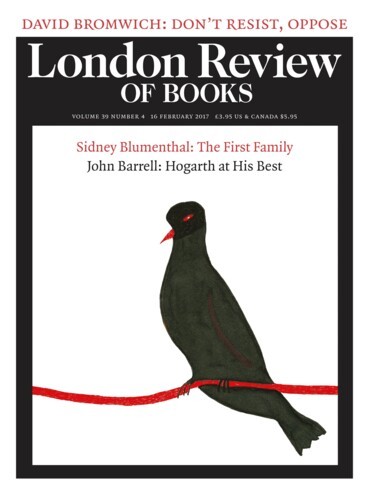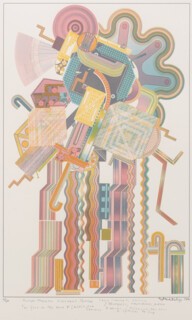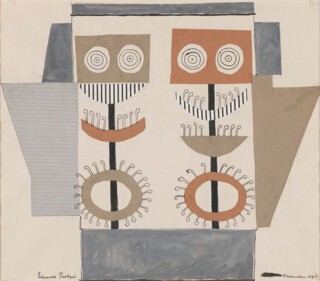Born to Italian shopkeepers in Edinburgh in 1924, Eduardo Paolozzi was a key member of the Independent Group (IG) of artists, architects, curators and critics formed in London in the early 1950s. He was especially active in the New Brutalist wing of the IG, which also included the artists Nigel Henderson, William Turnbull and Magda Cordell, the architects Peter and Alison Smithson, and the critic Reyner Banham. In the late 1980s the Smithsons looked back on the ‘as found’ aesthetic of New Brutalism as ‘a confronting recognition of what the postwar world actually was like’: ‘In a society that had nothing you reached for what there was, previously unthought of things … We were concerned with the seeing of materials for what they were: the woodness of wood, the sandiness of sand. With this came a distaste of the simulated.’ Implicitly here the Smithsons were positioning New Brutalism against the simulacral culture of American advertising then on the rise, yet the IG was also fascinated by this new culture and, with its echo of the objet trouvé, the ‘as found’ advanced its own version of image-making too.
This tension between material and image charged most New Brutalist activities; certainly it led Paolozzi and Henderson to renew the avant-garde practice of collage in the form of an aesthetic of tackboard juxtaposition. Collage is ‘my only method’, remarked Paolozzi, who extended it to the verbal mélange of his poetry and prose, and the same was true of Henderson, especially in his clotted ‘screens’ of found images. The two friends were familiar with Dadaist and Surrealist practices from London and Paris, where Paolozzi lived and Henderson visited from summer 1947 to autumn 1949. ‘That French approach, the need, the passion, to consider and handle things at the same time … is very necessary for me,’ Paolozzi claimed. ‘The concern with different materials, disparate ideas … becomes almost a description of the creative act – to juggle with these things.’ However, Dadaist and Surrealist collages were pledged to disturbance, political and psychosexual; Paolozzi’s images more ambiguous in effect. With material drawn from war-damaged books purchased cheaply in London, he sometimes overlaid pictures of classical sculptures with cutouts of contemporary machines in a way that suggested the modernity celebrated by Dada and Surrealism had already arrived – with disastrous results. To substitute a cross-section of a broken mechanism for a classical head of Zeus or Demeter, as Paolozzi did in collages dated to 1946, is to travesty the modernist worship of the machine god.
Paolozzi carried this travesty forward in his bronze sculptures of the 1950s. Cast at the Hampstead home of the director of the ICA, Dorothy Morland, his first homunculi have blobby heads and stubby arms, and, though a few gesture emphatically, it isn’t clear what they are communicating – perhaps the inability to communicate at all. ‘The consuming interest of Paolozzi is with the physiological and psychological limits of man,’ the IG convener, curator and critic Lawrence Alloway wrote of the figures. ‘These limits have been widened lately, with concentration camps, exposure at sea, the pressure of -45 gravities. It is to find an image of man tough enough and generalised enough to stand up in this environment that Paolozzi is working.’
Early on this theme of man under stress, in mutation even, is explicit, perhaps too much so. By the mid-1950s, however, Paolozzi found ways to integrate the subject of survival into the making of his work with a signature technique that also allowed him to expand the size of his figures. ‘I began with clay rolled out on a table,’ he explained.
Into the clay I pressed pieces of metal, toys etc. I also sometimes scored the clay. From there I proceeded in one of two ways. Either I would pour wax directly onto the clay to get a sheet or I would pour plaster onto the clay. With the plaster I then had a positive and a negative form on which to pour the wax. The wax sheets were pressed around forms, cut up and added to forms or turned into shapes on their own.
In effect Paolozzi updated the ancient method of lost-wax casting in a way that circumvented the usual approaches to sculpture, or rather that combined, in contradictory fashion, the traditional modelled figure and the avant-garde found object. For here ambiguous traces of readymade fragments were used to compose misshapen creatures that have both organic and mechanical aspects but lack the coherence of either the body or the machine.
In 1958 Paolozzi gave a list of materials impressed in his moulds:
Dismembered lock, Toy frog, Rubber dragon, Toy camera, Assorted wheels and electrical parts, Clock parts, Broken comb, Bent fork, Various unidentified found objects, Parts of a radio, Old RAF bomb sight, Shaped pieces of wood, Natural objects such as pieces of bark, Gramophone parts, Model automobiles, Reject die castings from factory tip sites. Car wrecking yards as hunting grounds.
He summed up his ‘action’ on this ‘rubbish’ – which, significantly, ranged from remnants of the industrial past to fragments from the consumerist present – in a manner that mimics linguistically what he performed sculpturally: ‘Burn cut mould model construct tack destroy & Recombine.’ ‘The word “collage” is inadequate as a description,’ Paolozzi remarked of this way of working, ‘because the concept should include damage, erase, destroy, deface and transform.’ In such descriptions lies his signal innovation in modernist object-making: to adapt the practice of collage to the tradition of the figure, and thereby to alter both; more, to conceive a form of artistic construction that keeps faith with the fact of historical destruction – not only the virtual ruin of humanist conceptions of ‘man’ and ‘sculpture’, but also the actual devastation wrought by the World War, the Holocaust and the Bomb.
Paolozzi delivered his comments on material and method in a lecture on ‘the metamorphosis of rubbish’ at the ICA in April 1958, in which he alluded to the 37 sculptures he would show at the Hanover Gallery at the end of the year. Both the heads and the figures in this large group appear damaged, but whereas the heads seem obdurate, the figures look fragile. With stilts for legs, they do not stand so much as they are stuck, feetless, on thin plinths. Most are armless too, so gesture is still stunted, and if they possess genitals at all, they are only craggy boards or little cogs, so they appear sterile as well. ‘Paolozzi has never made a female figure,’ Alloway noted in 1963, yet these creatures aren’t quite male either; they appear almost degendered, bachelor machines that aren’t even bachelors. And, again, they are assembled from traces of the world – broken toys and tools, loose nuts and washers – that are imprinted on the sculptures, almost as the sculptures. Hollow and brittle, the sculptures thus develop outside in, not inside out. The exteriors don’t express any interior, as is usually the case with traditional sculpture; in fact they don’t seem to express any interiority, any subjectivity, at all.
So what kind of subject do they intimate? Gestalt psychology was a central topic among former IG members. In his essay ‘The Expendable Ikon’, which appeared in early 1959 only two months after the Hanover show, the artist and critic John McHale alludes to Rudolf Arnheim, who first applied Gestalt theory to art, and cites Paul Schilder on the ‘fragmentary associations’ that we fold into our body images. Similar reflections on the infantile development of the corporeal imago had been made by Jacques Lacan in his celebrated paper on the ‘mirror stage’ a decade earlier. In it he likens the achieved ego to a stadium and even a fortress, and in his 1958 lecture Paolozzi also refers to an ‘architectural anatomy’ that guided the making of his figures – legs are likened to columns, torsos to towers and so on. Yet he envisions these parts as both ‘petrified’ and ‘cracked’, even ‘shattered’: unlike the infant in the mirror stage, no coherent body ego is posited – on the contrary. The damage undergone by these figures extends to the senses as well: if eyes, ears and mouths appear at all, they are represented as broken wheels and the like. (Touch, long deemed the most primitive of the senses, is privileged here, and the sheer tactility of the sculptures affects our viewing as well.) Apparently Paolozzi identified with his pieces especially on this score; certainly he played up his own persona as big, lumpen, brutish.
Why, then, did Paolozzi give heroic titles to so many of his sculptures? Apart from a few generic ‘heads’ and ‘figures’, they include such terms as ‘warrior’, ‘king’ and ‘god’. Although his personages hardly appear triumphal or sovereign, his titles aren’t satirical, at least not in any simple sense. He named some of his pieces after characters in Greek myth, with an emphasis on the defeated and the doomed. He represented the Cyclops twice, once as a head with a flattened face, once as a figure whose one eye, blinded by Odysseus, is again depicted as a broken wheel. The Hanover show also included two versions of Icarus, the mythical incarnation of human hubris. In his revision of the story, Paolozzi burdens Icarus with a large head in the first version and massive legs in the second, while in both pieces his wings are mere stubs. According to Paolozzi, either Icarus never flew, never transcended the materiality of the earth, or he had already crashed. Here too Paolozzi reinforces his theme with his process: like Odysseus he gouges his Cyclops, and like the sun he strips his Icarus down.
The legendary figure that truly absorbed Paolozzi during this time was a Christian, St Sebastian, whom he represented in no fewer than five sculptures. A Roman soldier martyred for his faith, Sebastian was a favourite subject in the Renaissance because, as a pagan convert, he provided an occasion for the ideal body of classical art to be repositioned in a dramatic scene of Christian sacrifice. Traditionally Sebastian is depicted as riddled with arrows, and Paolozzi also shoots his saint through with holes (in a sense, they alone hold his various versions together). Sebastian survived his wounds, however, which is why his image was often taken up as a talisman of protection (especially against plague). ‘My St Sebastian was a sort of God I made out of my own necessity,’ Paolozzi remarked enigmatically, and perhaps this necessity also involved a kind of safeguard. Conceivably this is what he found heroic in all his figures, classical, Christian and other: damaged to the point of death, they still survive (at the very least they persist as the stuff of legend). Again, both ‘man’ and ‘sculpture’ were in a perilous state in the postwar era: maybe Paolozzi believed that this damaged condition could be recouped as a form of protection (or, again, of persistence). ‘The Figure is a Thing,’ he said, also enigmatically, about his pieces of this period. Could it be, paradoxically, that they are built to last precisely because they are as rickety as they are reified, not in spite of this fact?
These figures can be taken as avatars of survival in another way too, if we understand the imprinting of the world as somehow mimetic of a changed state of human evolution in the modern period. The classic text On Growth and Form (1917) by the Scottish biologist D’Arcy Wentworth Thompson came as a revelation to Paolozzi when he discovered it in 1948; he soon passed it on to IG colleagues like Richard Hamilton (who produced an extraordinary exhibition on the topic in 1951). For Thompson biological forms are determined by forces both internal and external, such that what appears to be a deformation within a structure is often an adaptation to the environment. The graphs in On Growth and Form chart how ‘new figures’ emerge from ‘old figures’ as an organism undergoes ‘a more or less homogenous strain’ from the world. One can see why this account would interest Paolozzi, even though he imagines such transformation very differently. In Thompson metamorphosis tends to be mathematically perfect, which is obviously not the case with Paolozzi, and, unlike Thompson, Paolozzi conjures up creatures in which the organic and the mechanical are convoluted. In fact his ‘uneasy animals distorted with tekno motors’ (as he once called them) are ciphers of this very complication.
In Mechanisation Takes Command (1948), another text championed by Paolozzi, the Swiss architectural historian Sigfried Giedion designates ‘the period between the two World Wars as the time of full mechanisation’, that is, the time when ‘it impinged upon the very centre of the human psyche, through all the senses.’ He offers an ‘anonymous history’ of this impinging through case studies of such devices as the lock and the reaper and such procedures as the production of poultry and pork (which he calls ‘the mechanisation of death’). Giedion drew out two ramifications that Paolozzi found particularly relevant. The first is that, by the late 19th century, the reproducibility of objects permitted by mechanisation led to a ‘devaluation of symbols’, as craft became deskilled and ornament became rote. The second is that, by the early 20th century, mechanisation had ‘penetrated the subconscious’, with the implication that the psyche came to be understood as a mechanism, even an automatism, in its own right.
In his sculptures of the 1950s Paolozzi effectively reads Thompson and Giedion through each other, which is to say that he presents the transformation of the human form ‘under strain’ in terms of a mechanisation that had ‘taken command’ in society at large: this impinging on the body and the psyche alike is his primary concern. Yet Paolozzi is closer still to another source he probably didn’t know: the Freud of Beyond the Pleasure Principle (1920). In this text, which advances the theory of the death drive, Freud also puts forward the strange hypothesis that, in order to survive, every organism evolves a ‘protective shield’ out of the stimuli it receives from the world. The shield develops as the surface of the organism hardens into a crust under the force of these stimuli; the crust protects the nervous system at the organism’s core. ‘Protection against stimuli,’ Freud insists, ‘is an almost more important function for the living organism than reception of stimuli.’ The analogy to Paolozzi is clear enough, and Alloway had already glimpsed it. His ‘figures adapt to the environment … by incorporation’, Alloway wrote. ‘The texture on the sculptures of the 1950s consists of a scrambled anthology of our essential artefacts. The body assimilates these objects, like a wall of fossils.’
Beyond the Pleasure Principle proposes a dialectic of stimuli and shield, of reception and protection, that sustains the organism in a state of nature. But surely this dynamic continues in a state of second nature too; that is, in a modern environment transformed by industrial production and consumption. In fact it comes under all the more pressure in this technological epoch, to the point where, as Giedion puts it, mechanisation ‘impinges upon the very centre of the human psyche’. After the industrialised killing of the Second World War, this dynamic enters a new phase. It becomes less a dialectic than a deadlock: it is as though the subject were not only stressed by shock but hardened all the way through. If any art can evoke such a state, it would be a sculpture in which the figure is indeed a ‘Thing’, in which the body is little more than a brittle shield built up, under strain, of literal impressions from a broken world – maybe with no inside any more, no nervous system at its core, to protect at all. Paolozzi pointed to this reading of his work when he described the head of his St Sebastian II (1957) as ‘a dome, a shell, partly bent under pressure’. At the same time he presented the piece as ‘an anti-mechanism’, in symbolic resistance to a mechanisation turned destructive; perhaps he even intended his thingly sculpture to possess an apotropaic force. Could it be that Paolozzi brutalised his figures in order to register not only the violence of this historical process but also to recoup that violence as a belated form of protection against it? (Such, again, is the apotropaic aspect of images of St Sebastian.) Might this be the ‘necessity’ to which his sculptures of the 1950s respond – as if, in a perverse troping of Christ, what is dead cannot die or, rather, in a paradoxical updating of Nietzsche, what kills me makes me strong?
Send Letters To:
The Editor
London Review of Books,
28 Little Russell Street
London, WC1A 2HN
letters@lrb.co.uk
Please include name, address, and a telephone number.





